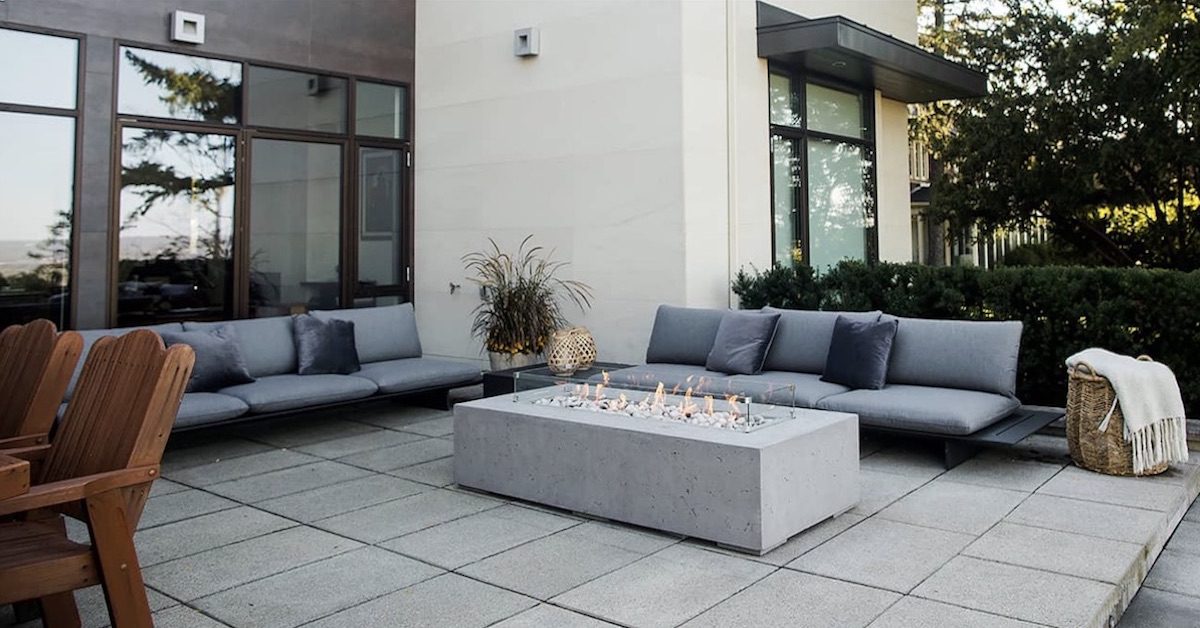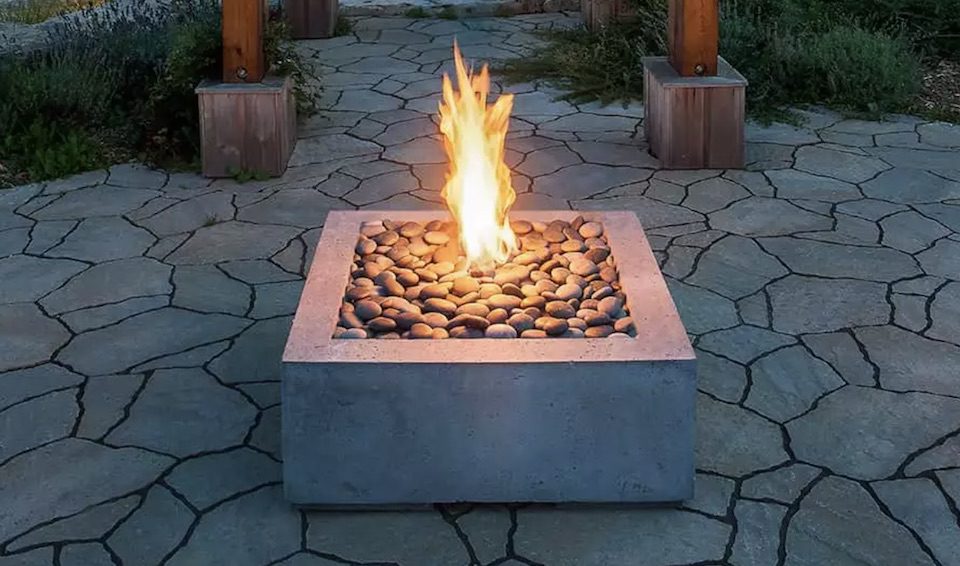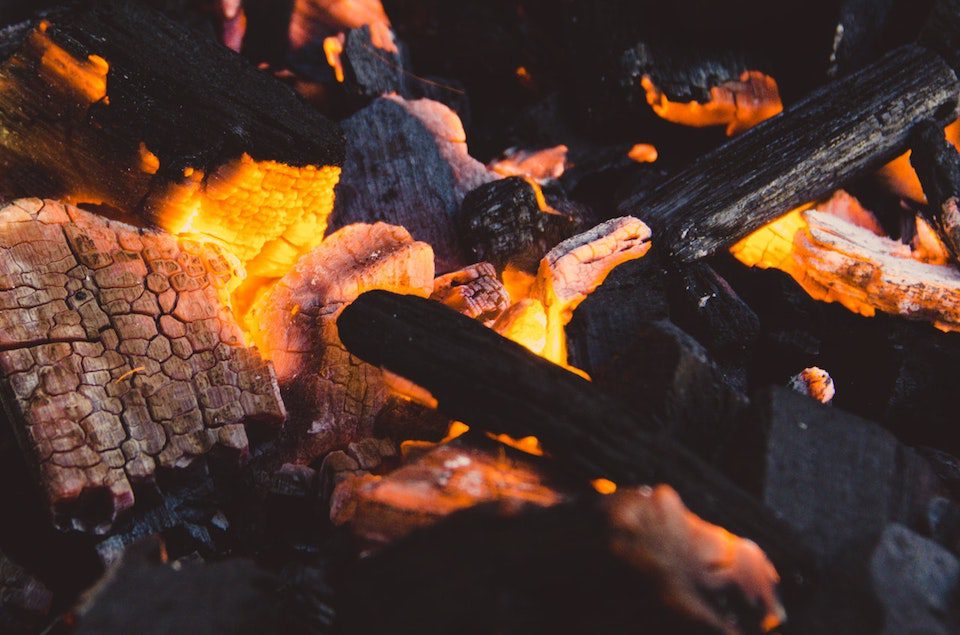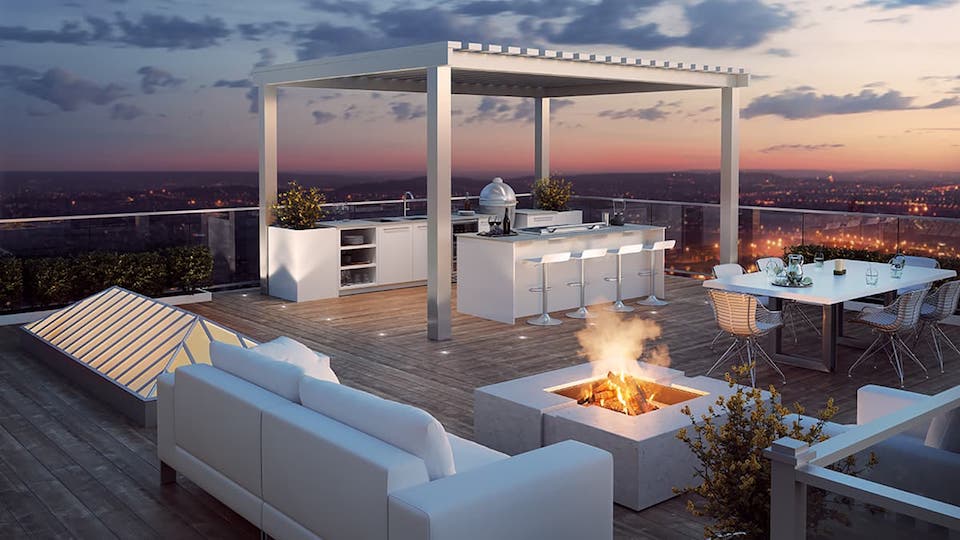We’re all looking for an escape from the all-too-familiar four walls of our homes.
Canada has experienced a sluggish pandemic vaccine rollout, so lockdowns and travel restrictions continue to be our reality for a little while longer.
As the weather gets warmer, this means our homes will be where the majority of our time continues to be spent.
Take this opportunity to make the best of a bad situation. Upgrade a part of your home that may be getting overlooked – the backyard. With a little creativity, you can create a beautiful outdoor living area for your family to enjoy.
By adding a gas fire pit or wood-burning fire pit to an exterior area that extends your living space, you can also enjoy the great outdoors virtually year-round.
Which type of fire pit will suit your needs best? Let’s take a look at some pros and cons between gas fire pits and wood-burning fire pits.

Gas fire pits vs. wood-burning fire pits: cost difference
One of the first questions most people choosing between a gas fire pit and wood-burning fire pit have is the cost difference. In both cases, the size of the fire pit will factor into the cost.
The materials the fire pit is made with is another factor that will determine the product’s cost. Common fire pit materials include:
- cast iron
- concrete
- copper
- steel
- granite
Wood-burning fire pits tend to have cheaper upfront costs compared to gas and propane fire pits. Big-box stores offer a range of budget-friendly models that can be assembled yourself.
Natural gas fire pits typically cost a little more. Part of that cost can be attributed to the need for a professional to install the unit. The BTU output of propane and natural gas fire pits (meaning the amount of heat they produce) is another detail that affects cost.
Additional factors to consider are the ongoing costs to operate a fire pit. Naturally (no pun intended), your natural gas or liquid propane costs will be determined by how often your fire pit is used.
Wood-burning fire pits need plenty of firewood to operate. That can get expensive if you don’t have an endless supply of wood on your property and need to have it delivered.

Wood-burning fire pits give you that authentic campfire feel. Just be prepared for the extra work involved, like cutting and hauling lots of wood. (Photo by Oziel Gómez from Pexels)
Installing wood-burning and gas fire pits
Fire pits can be built from the ground up in a variety of shapes with masonry products such as paver stones, bricks, and heat-resistant outdoor stucco. Most homeowners will choose to buy a pre-made fire pit, however.
One benefit of wood-burning fire pits is they can be assembled yourself. They can be placed anywhere in a backyard with a stable, level surface and enough open space.
Gas fire pit installations involve more planning and aren’t as straightforward to set up. To ensure a gas fire pit is installed properly and works safely, a certified gas technician should be hired.
Setting up a natural gas line for a fire pit will be less of a logistical issue if you’re already planning to add a built-in gas grill to an outdoor kitchen.
Fire pits that run on propane use the same type of small tank that propane grills do, so their setup process is relatively straightforward. If using a larger propane tank is preferred, the services of a professional would be required to install it.
Fuelling your outdoor fire: what you need to know
The convenience of using natural gas when compared to using wood to fuel a fire pit is undeniable. A dedicated natural gas line provides a never-ending supply of fuel. Once it’s installed, your only concern will essentially be paying your monthly gas bill!
One issue that may make natural gas impractical for a fire pit is the location of your property. In rural locations that don’t have access to natural gas services, wood and propane fire pits are your only options.
Propane fire pits offer a little less convenience since the tanks they use need to be refilled or switched out. You can invest in a larger permanent propane tank to cut down on the need to regularly refill your fuel supply. Cottage Life magazine explains here why “propane is super practical for the cottage”.
Wood-burning fire pits, on the other hand, require a lot more work and planning to operate. Here are four questions to ask yourself if you’re considering buying a wood-burning fire pit:
- Can you handle the physical demands of cutting down trees and splitting, moving, and stacking wood?
- If you need to have firewood delivered, can you get the right type of wood in a timely manner from a reliable company?
- Are you willing to invest the extra time it takes to maintain a wood-burning fire pit (especially cleaning it)?
- Do you have a dry place away from your house or cottage that can be used for firewood storage?
How easy is it to start and extinguish fires?
The ease of use of a fire pit ends up being a major factor when choosing what type to buy.
One of the biggest drawbacks of wood-burning fire pits is the amount of time and effort it can take to light them. Sometimes, even more time is needed to put them out!
To fully extinguish a wood fire in a pit, the best practice is to allow the wood to fully burn down to ashes. Follow that up by pouring at least a couple of buckets of water over the pit area. When no sign of burning embers is left and no sizzling sound from the water can be heard any longer, the fire should be safely out.
Or you could just push a button to start and stop your outdoor fire.
Here’s one area where the convenience of a propane or natural gas fire pit stands out. Gas fire pits come with a variety of ways to get a fire started easily. The quickest method is via a remote ignition system that starts the fire with the flick of a wall switch or press of a remote control button. Push button ignition systems (like the ones propane grills have) are another type. Some inexpensive gas fire pits can be started the old-fashioned way – with a match or lighter stick.
Turning off an outdoor fire with a gas fire pit is just as easy as starting it. With the press of a button or by shutting off the pit’s gas supply valve, the fire is safely extinguished.

Natural gas and propane fire pits offer the convenience of instant ignition systems.
What type of fire pit is legal in my backyard?
Zoning restrictions in your area will dictate what type of fire pit you can and cannot use, so research your local laws and regulations before making a purchase.
In Vaughan, wood-burning fire pits, fireplaces, and chimineas are allowed, but they are restricted in Toronto.
Areas that do permit outdoor wood burning can issue temporary fire burn bans when dry weather conditions increase the risk of grass, trees, and other vegetation catching fire.
Because natural gas and propane fire pits allow for more control when they’re being used, they’re considered much less of a safety hazard.
Your best option for complying with Ontario’s Fire Code is to get a propane or natural gas fire pit that is certified by the Technical Standards and Safety Authority (TSSA.)
Gas fire pit vs. wood-burning fire pit smoke output
One of the most appealing features of burning wood is the unique ambiance it provides. The cozy warmth, crackling logs, dancing flames, and pleasant smell generated by an outdoor fire can’t be beat.
Unfortunately, those benefits are accompanied by one glaring negative – the smoke. Nothing spoils a fun time around an outdoor fire like having too much smoke cause your eyes to sting and tear up, or having to constantly change where you’re sitting to avoid blowing smoke.
Wood fires also lose some of their appeal when the odour from the smoke gets into your hair and lingers on your clothing. Drifting smoke into the yards of your neighbours may not be appreciated, either. The Canadian Lung Association actually recommends that you don’t burn wood in a residential setting because of the potential respiratory problems it can cause.
Outdoor fires fuelled by natural gas and propane admittedly deliver a more “sterile” burning experience. Although they may lack the authenticity and charm of a wood-burning fire, at least there’s no smoke to contend with.
Emissions and energy-efficiency of fire pits
The lack of smoke produced by a gas fire pit makes it significantly more energy-efficient than burning wood. The cleaner burn of natural gas emits 99% fewer emissions than wood. Propane burns cleaner than wood, but not as cleanly as natural gas.
Using gas or propane for a fire pit is more eco-friendly in another way besides reducing the amount of pollutants you put into the atmosphere. You’re not contributing to live trees being cut down to produce any firewood.
Gas fire pits are also energy-efficient because they provide a steady, controllable level of heat. The same can’t be said of wood-burning fires, which can be unpredictable and difficult to maintain at a comfortable heat level.
How easy is it to maintain a gas fire pit or wood-burning fire pit?
The convenience advantage of gas fire pits compared to wood-burning fire pits extends to the level of maintenance they need.
Wood-burning fire pits need to be cleaned after each use, requiring you to dispose of the leftover ashes. The process of gathering wood to burn (whether it’s doing it yourself or having it delivered) also qualifies as maintenance for the fire pit.
A gas fire pit involves relatively little maintenance since there’s nothing solid being burned. The most you’ll have to do is occasionally wipe it down and inspect the gas lines for blockages and leaks. For propane fire pits, you’ll have to replace the propane tank once in awhile.
Any fire pit should be covered when it’s not being used to protect it from rain and snow.

Ashes should be cleaned out of a wood-burning fire pit after every use. (Photo by Barthy Bonhomme from Pexels)
What type of fire pit is the most durable?
Covering a fire pit when you’re not using it will extend its life, but you still need to make sure the product you’re buying is made with high-quality materials that will last for years.
Between the heat generated by a fire pit and the fact it’s located outdoors, cheap materials will break down quickly.
Those budget-friendly fire pits we mentioned earlier are usually made with cheap steel that is manufactured overseas. They tend to rust quickly and you’ll end up replacing the entire pit sooner than you’d prefer to.
Concrete gas fire pits are very durable. Outeriors sells handcrafted Dekko fire pits that are made with a proprietary lightweight concrete that is is less than half the weight of regular concrete. The Ontario-based manufacturer states that “Our products are built with longevity in mind”.
How safe are gas and wood-burning fire pits?
All types of fire pits require vigilance and care when they’re being used.
Gas fire pits pose less of a fire hazard than wood-burning fire pits, but they still need to be periodically inspected and maintained for maximum safety. When lighting a propane or natural gas fire pit manually, it’s wise to use a longer lighter stick or a metal match stick holder to keep you further away from the ignition point.
Always shut off the propane or natural gas when you’re finished using the fire pit. Some gas fire pit models have features like automatic turn-off timers that remove the guesswork of whether or not you remembered to turn the unit off. Tempered glass wind guards are another safety feature worth considering.
Because of the sparks and embers produced, wood-burning fire pits can’t be placed too close to your home, wood structures, or anything that is flammable. A wood fire needs to be monitored even more closely when it’s windier. Fire pit spark screens that prevent embers from leaving the pit area are a good investment. And once again, wood fires need to be fully extinguished when you’re finished enjoying them.

With the right setup and safety measures, it is possible to install gas and wood-burning fire pits on a wooden or composite deck.
I want to purchase a gas fire pit. What’s next?
Now that you have a better understanding of the pros and cons of wood-burning and gas fire pits, you can make a more informed decision on the fire pit best suited for your outdoor living space.
Outeriors has a variety of propane and natural gas concrete fire pit designs and accessories by Dekko to help you enjoy more time in your backyard throughout the year.
If you’d like to go beyond a fire pit and create an outdoor kitchen or upgrade your outdoor living space in other ways, request a free consultation with us today. You can also visit our showroom in Vaughan to learn more.
Please share this post if you found it useful.